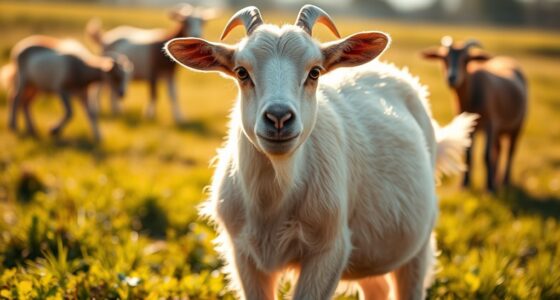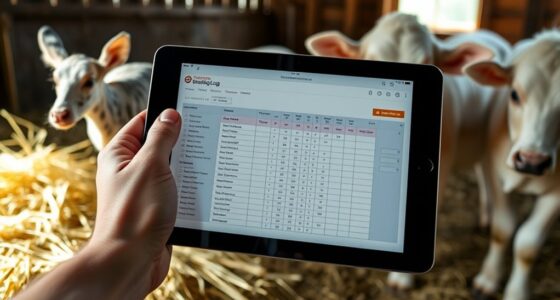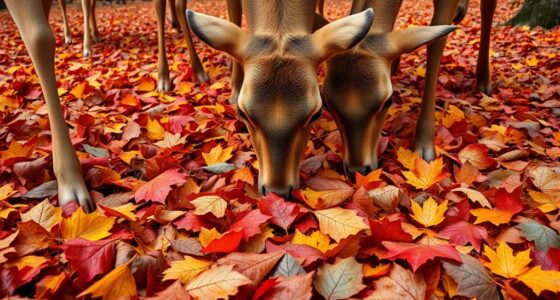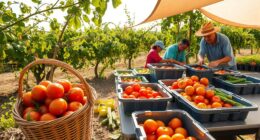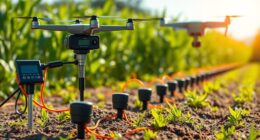To manage heat stress in livestock, make certain constant access to clean, fresh water and use cooling systems like fans, sprinklers, or shaded structures to lower ambient temperatures. Schedule feedings during cooler times and minimize handling during the hottest parts of the day. This proactive approach helps prevent dehydration, overheating, and related health issues. Staying vigilant and combining these strategies can greatly improve your herd’s resilience and well-being during hot weather. Keep exploring to learn more effective techniques.
Key Takeaways
- Implement cooling systems such as fans, sprinklers, and shade structures to lower ambient temperatures around livestock.
- Ensure constant access to clean, fresh water and monitor intake to prevent dehydration during hot weather.
- Schedule feeding and reduce activity during peak heat hours to minimize heat generation and stress.
- Combine environmental controls with hydration strategies for comprehensive heat stress prevention.
- Maintain good ventilation and early intervention to safeguard animal health and improve resilience to heat stress.
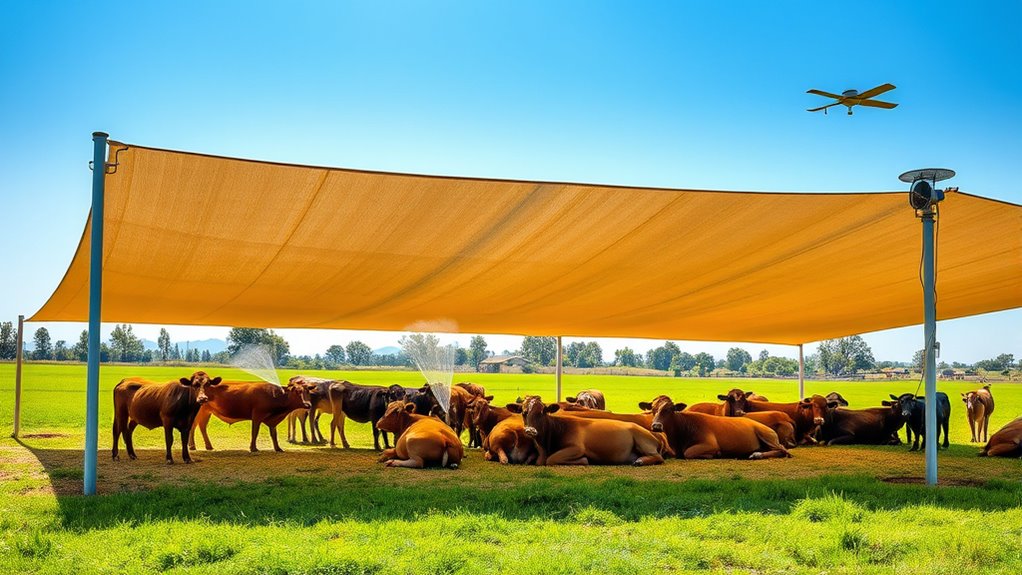
Have you ever wondered how heat stress affects your livestock and what you can do to manage it? High temperatures can quickly impair your animals’ health, reduce productivity, and even lead to death if not addressed promptly. Understanding how to mitigate heat stress is essential for maintaining a healthy, productive herd. One of the most effective ways to do this is by implementing cooling systems. These systems include fans, sprinklers, misting devices, or shade structures that help lower the ambient temperature around your animals. Fans promote air circulation, dispersing heat and moisture, while sprinklers and misters provide a cooling mist that helps lower body temperature directly. Shade structures, whether natural or artificial, shield your livestock from direct sunlight, preventing overheating. Installing proper cooling systems is an investment that pays off by reducing heat-related stress, improving feed intake, and increasing overall productivity.
Implementing cooling systems like fans, sprinklers, and shade structures reduces heat stress and boosts livestock productivity.
Alongside cooling systems, hydration strategies play a critical role in managing heat stress. When temperatures soar, animals lose more water through sweating and respiration, making it essential to ensure constant access to clean, fresh water. You should provide multiple water sources throughout your facilities, especially in high-traffic areas, to encourage frequent drinking. Monitoring water consumption helps you identify early signs of dehydration or illness. Offering electrolyte supplements can also support hydration and replenish minerals lost through sweating. It’s important to adjust watering schedules during peak heat hours, ensuring animals have easy access at all times. Proper hydration aids in cooling the body naturally and prevents heat exhaustion, which can be deadly if ignored.
You should also pay attention to the timing of feeding and activity. During the hottest parts of the day, try to minimize handling or movement of your livestock to reduce additional heat generation. Instead, schedule feeding and other management tasks during cooler early mornings or late evenings. This reduces stress and prevents animals from becoming overly fatigued or overheated. Additionally, maintaining good ventilation in barns or shelters enhances the effectiveness of cooling systems and helps keep the environment comfortable.
Incorporating these strategies—installing effective cooling systems and maintaining strong hydration protocols—can greatly reduce heat stress in your livestock. By proactively managing the environment and ensuring animals stay well-hydrated, you help safeguard their health, improve their productivity, and safeguard their well-being during hot weather. Remember, the key is consistency and vigilance; the sooner you implement these measures, the better your animals will fare under heat stress conditions.
Frequently Asked Questions
What Are the Early Signs of Heat Stress in Different Livestock Species?
You’ll notice early signs of heat stress in livestock through behavior changes and physiological signs. They may become more restless, seek shade, or reduce feed intake. Physiologically, watch for increased respiration rates, excessive salivation, and elevated body temperature. Some animals may also show decreased milk production or unusual vocalizations. Recognizing these early signs helps you take prompt action to prevent more severe health issues caused by heat stress.
How Does Heat Stress Impact Livestock Reproductive Performance?
Heat stress decreases livestock reproductive performance by causing hormonal disruption, which affects fertility and conception rates. You might notice reduced estrus expression and lower pregnancy success. Genetic resilience plays a role; animals with better resilience handle heat better, maintaining fertility levels. To protect your livestock, guarantee proper cooling strategies and select for resilient genetics, helping to minimize heat stress’s negative impact on reproduction and keep your herd productive.
Are There Specific Breeds More Resistant to Heat Stress?
Yes, certain breeds are more resistant to heat stress due to breed resilience. You can improve your herd’s tolerance by focusing on genetic selection, choosing breeds like Brahman or Zebu that naturally withstand high temperatures. These breeds have adaptations such as better heat dissipation and moisture regulation. By prioritizing genetic resilience, you guarantee your livestock remain healthier and more productive even during extreme heat conditions.
What Are Cost-Effective Cooling Methods for Small-Scale Farmers?
You can implement cost-effective cooling methods like evaporative cooling systems and providing ample shade to protect your livestock. While some might worry about water usage, evaporative cooling is efficient and affordable, especially with simple setups like fans and misters. Shade provision, whether through natural tree cover or constructed shelters, reduces heat stress and boosts animal comfort without breaking your budget, making it ideal for small-scale farmers.
How Can Nutrition Be Adjusted to Mitigate Heat Stress Effects?
You can adjust nutrition to mitigate heat stress by optimizing dietary electrolyte balance, ensuring your livestock maintain proper hydration and nerve function. Additionally, modify feed formulation by increasing energy density with easily digestible ingredients to reduce internal heat production. Providing fresh, cool water and feeding during cooler parts of the day also helps. These strategies support your animals’ resilience to heat, keeping them healthier and more productive during hot periods.
Conclusion
To effectively manage heat stress in livestock, stay vigilant and implement cooling strategies like shade, proper ventilation, and water. Think of your animals as delicate flowers in a scorching sun — without care, they wilt and suffer. By proactively addressing heat, you create a shield that keeps them thriving, ensuring their health and productivity. Remember, your attentive actions are the gentle rain that helps your livestock flourish even under the hottest skies.



